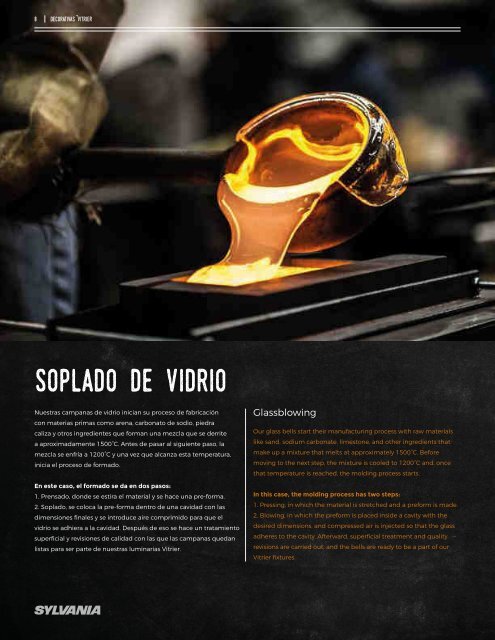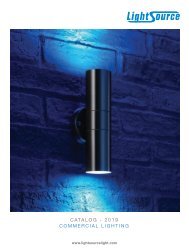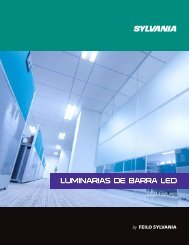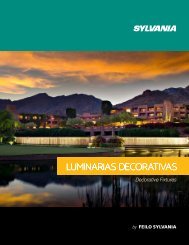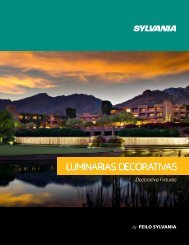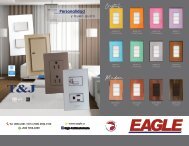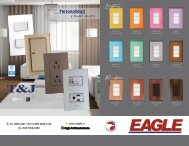Sylvania Linea Vitrier
You also want an ePaper? Increase the reach of your titles
YUMPU automatically turns print PDFs into web optimized ePapers that Google loves.
8<br />
Decorativas <strong>Vitrier</strong><br />
<strong>Vitrier</strong> Decoratives<br />
9<br />
Repujado de aluminio<br />
Las piezas metálicas que<br />
complementan a las luminarias<br />
<strong>Vitrier</strong> se fabrican mediante<br />
un proceso muy especial<br />
y poco conocido, llamado<br />
repujado de aluminio. Este<br />
proceso transforma discos<br />
planos de aluminio en todo<br />
tipo de campanas y formas que<br />
diferencian nuestros productos.<br />
Aluminum Embossing<br />
The metallic pieces that<br />
complement <strong>Vitrier</strong> fixtures are<br />
manufactured through a very<br />
special and little-known process<br />
called aluminum embossing.<br />
This process transforms flat<br />
aluminum discs in all sorts of<br />
bells and shapes that distinguish<br />
our products.<br />
Cada una de las piezas fabricadas<br />
en este proceso es única ya<br />
que son una combinación del<br />
expertise de nuestros operarios<br />
junto con el gran valor estético de<br />
nuestros diseños. Estas piezas al<br />
igual que las piezas de vidrio, se<br />
someten a revisiones constantes<br />
para asegurar la calidad del<br />
producto final.<br />
Each of the pieces<br />
manufactured through this<br />
process is unique because<br />
they are a combination of our<br />
workers’ expertise and the great<br />
esthetic value of our designs.<br />
These pieces, just like the glass<br />
ones, are subdued to constant<br />
inspections to assure the quality<br />
of the final product.<br />
Soplado de vidrio<br />
Nuestras campanas de vidrio inician su proceso de fabricación<br />
con materias primas como arena, carbonato de sodio, piedra<br />
caliza y otros ingredientes que forman una mezcla que se derrite<br />
a aproximadamente 1500°C. Antes de pasar al siguiente paso, la<br />
mezcla se enfría a 1200°C y una vez que alcanza esta temperatura,<br />
inicia el proceso de formado.<br />
En este caso, el formado se da en dos pasos:<br />
1. Prensado, donde se estira el material y se hace una pre-forma.<br />
2. Soplado, se coloca la pre-forma dentro de una cavidad con las<br />
dimensiones finales y se introduce aire comprimido para que el<br />
vidrio se adhiera a la cavidad. Después de eso se hace un tratamiento<br />
superficial y revisiones de calidad con las que las campanas quedan<br />
listas para ser parte de nuestras luminarias <strong>Vitrier</strong>.<br />
Glassblowing<br />
Our glass bells start their manufacturing process with raw materials<br />
like sand, sodium carbonate, limestone, and other ingredients that<br />
make up a mixture that melts at approximately 1500°C. Before<br />
moving to the next step, the mixture is cooled to 1200°C and, once<br />
that temperature is reached, the molding process starts.<br />
In this case, the molding process has two steps:<br />
1. Pressing, in which the material is stretched and a preform is made.<br />
2. Blowing, in which the preform is placed inside a cavity with the<br />
desired dimensions, and compressed air is injected so that the glass<br />
adheres to the cavity. Afterward, superficial treatment and quality<br />
revisions are carried out, and the bells are ready to be a part of our<br />
<strong>Vitrier</strong> fixtures.


